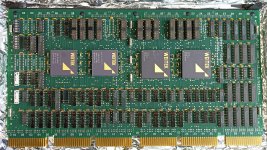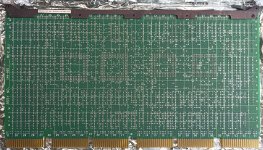Upcoming Events:
- VCF South West - June 14 - 16, Davidson-Gundy Alumni Center at University of Texas at Dallas
- VCF West - Aug 2 - 3, Computer History Museum, Mountain View, CA
- VCF Midwest - Sept 7 - 8 2024, Schaumburg, IL
- VCF SoCal - Mid February 2025, Location TBD, Southern CA
- VCF East - April 2025, Infoage Museum, Wall NJ
-
Please review our updated Terms and Rules here
You are using an out of date browser. It may not display this or other websites correctly.
You should upgrade or use an alternative browser.
You should upgrade or use an alternative browser.
Unknown Unibus-like WEITEK CPU board
- Thread starter marcopolo
- Start date
daver2
10k Member
A WEITEK XL-8136-100-GCD is a program sequencer unit.
A WEITEK XL-8137-100-GCD is a 32-bit integer processor.
A WEITEK 3332-100-GCD is an FPU.
A high performance, intelligent floating point unit?
I have also seen the 3332-100-GCD described as a graphics engine - but this would/could also be an FPU anyhow.
Dave
A WEITEK XL-8137-100-GCD is a 32-bit integer processor.
A WEITEK 3332-100-GCD is an FPU.
A high performance, intelligent floating point unit?
I have also seen the 3332-100-GCD described as a graphics engine - but this would/could also be an FPU anyhow.
Dave
Last edited:
Bitly
Experienced Member
The CSPI website from 1999 indicates they were into signal processing, so likely an FPU as Dave indicates.
Archived website
Note: It seems unlikely to be unibus given the Wietek parts are dated '87, and I would think a high-end signal processing system would use something better/faster than unibus.
CW
Archived website
Note: It seems unlikely to be unibus given the Wietek parts are dated '87, and I would think a high-end signal processing system would use something better/faster than unibus.
CW
marcopolo
Experienced Member
Thanks!
daver2
10k Member
Are you going to get it running?!
We might be able to tell from the power rails whether it is Unibus or Qbus - or some other bus...
Dave
We might be able to tell from the power rails whether it is Unibus or Qbus - or some other bus...
Dave
marcopolo
Experienced Member
No, I don't plan to turn it on
Unibus or Qbus with 74F374 as bus drivers ? I don't think that's possible.
I compared this card with my VAX 730 boards, same size, same golden fingers.
Marc
Unibus or Qbus with 74F374 as bus drivers ? I don't think that's possible.
I compared this card with my VAX 730 boards, same size, same golden fingers.
Marc
Chuck(G)
25k Member
Massbus might make some sense.
The123king
Member
It's definitely not QBUS, as those were 4 fingers wide, maximum, in CPUs. There are some QBUS/EF backplanes out there, but the extra 6 fingers are power only, and i believe they were only used as peripheral controllers and not full PDP-11 computers.
The 9 identical chips in the bottom left would indicate either 8bit+parity, or maaaybe a half-word for an 18-bit machine like the PDP-15. I'd bet money on it not being a PDP-8 board.
It's quite possible it's an upgrade board for an early VAXen
The 9 identical chips in the bottom left would indicate either 8bit+parity, or maaaybe a half-word for an 18-bit machine like the PDP-15. I'd bet money on it not being a PDP-8 board.
It's quite possible it's an upgrade board for an early VAXen
Last edited:
AK6DN
Veteran Member
Or maybe not for a DEC system at all, but they just found that module form factor convenient at the time and had their own custom backplane using DEC style connectors.
marcopolo
Experienced Member
AK6DN,
I think you're right.
I think you're right.
For a time, there were a couple outfits out there that made processor replacement/upgrades for things like the PDP-11/70 where you would rip out the CPU board stack and plug in a few boards which would emulate a PDP-11, but really fast. This looks very much like part of one of those. Hex-height and yet not Unibus.
marcopolo
Experienced Member
It's a pity that there is no documentation on this kind of board.
I might know of a set that's installed, so there is a chance of at least coming up with the normally installed configuration.It's a pity that there is no documentation on this kind of board.
Chuck(G)
25k Member
There is the matter of software to run on the things. Don't know how you'd find that
marcopolo
Experienced Member
I think it will be very difficult if not impossible.
I think the idea was it was a drop-in replacement emulator, similar to the PEP70/hypercache. After all, the whole idea was to allow customers to run their legacy systems and software, just faster.There is the matter of software to run on the things. Don't know how you'd find that
Sure, it's possible there was a microcode loader or something, but I suspect that was in one of the boards. I'll try to look at an installed one over the weekend.
Chuck(G)
25k Member
I'm not quite as sanguine--CSPI made a big business of selling signal processing hardware and software to the government.
But, good luck with that!
But, good luck with that!
pbirkel@gmail.com
Veteran Member
Well, I don't have Teletech's experience with third-party replacement/upgrades to PDP-11 CPUs, but AFAIK they all were exactly that -- board substitutions that were plug-in replacements for original DEC modules. No changes to the backplane ("system unit(s)"). Thus either it's a single module substitute which is an exact finger-signal match, or it's a multi-module substitute where there is a finger-signal match for all interfacing-signals plus an OTT connector/cable to handle unique inter-module signalling requirements. The limit-case is, of course, a single-slot Unibus (or Qbus) module that honors exactly the finger-signals on, e.g., Unibus A-B and doesn't do anything conflicting on C-D-E-F, such as an SPC-conforming module.
Furthermore it must be the case that the CPU replacement/upgrade is a functional superset of the original module(s) in those slots. To the extent that it offers enhanced functionality its operation must be "silent" (e.g., bigger or faster memory cache) or will likely require software changes (e.g., different OS driver or new software to use an extended API to access the new capabilities).
This module seems to satisfy none of those constraints. Considering the PDP-11/70, the only replacement scenario that makes any sense to me is as a FP11 four-module replacement (slots 2-3-4-5). Finger-signals to the CPU are spread across all four of those slots so any replacement would minimally need stub-modules to service the three other slots plus cabling from the replacement module to those other slots. The Weitek Integer processor would be either superfluous (lacking the ability to replace a subset of the 11/70 intrinsic ALU due to lack of signal-access alongside "disconnection" of the normal signal paths) or would require an enhanced instruction set for access alongside the existing CPU circuitry -- in essence a new peripheral device (as was the case for the initial PDP-11 floating-point HW).
IMO the only usage scenario here involves both a unique backplane and additional modules to interface to either the Unibus or translate/carry signals on cables to stub-modules judiciously placed to substitute for original CPU modules. Note that the 11/70 SU configuration doesn't leave space for addition of even a four-slot (1 SU) extension within the chassis. Slot 19 could be commandeered (as does the PEP-70) as a power source, but that can't address the signal-interface requirements without OTT cabling to slots 2-3-4-5, for which this module clearly has no provisions. Housing a FP11 replacement in an extension chassis with the necessary lengthy cabling strikes me as a non-starter due to timing requirements.
Furthermore it must be the case that the CPU replacement/upgrade is a functional superset of the original module(s) in those slots. To the extent that it offers enhanced functionality its operation must be "silent" (e.g., bigger or faster memory cache) or will likely require software changes (e.g., different OS driver or new software to use an extended API to access the new capabilities).
This module seems to satisfy none of those constraints. Considering the PDP-11/70, the only replacement scenario that makes any sense to me is as a FP11 four-module replacement (slots 2-3-4-5). Finger-signals to the CPU are spread across all four of those slots so any replacement would minimally need stub-modules to service the three other slots plus cabling from the replacement module to those other slots. The Weitek Integer processor would be either superfluous (lacking the ability to replace a subset of the 11/70 intrinsic ALU due to lack of signal-access alongside "disconnection" of the normal signal paths) or would require an enhanced instruction set for access alongside the existing CPU circuitry -- in essence a new peripheral device (as was the case for the initial PDP-11 floating-point HW).
IMO the only usage scenario here involves both a unique backplane and additional modules to interface to either the Unibus or translate/carry signals on cables to stub-modules judiciously placed to substitute for original CPU modules. Note that the 11/70 SU configuration doesn't leave space for addition of even a four-slot (1 SU) extension within the chassis. Slot 19 could be commandeered (as does the PEP-70) as a power source, but that can't address the signal-interface requirements without OTT cabling to slots 2-3-4-5, for which this module clearly has no provisions. Housing a FP11 replacement in an extension chassis with the necessary lengthy cabling strikes me as a non-starter due to timing requirements.
The system I saw was 4/5 boards that worked together. You scrape out all the CPU boards from a 70 (including FPU and memory), throw it all away, and plug these into the now empty front section of the backplane. As such, you only really need to make sure the boards grab the signals so they can run the massbus and unibus. Other than that the boards could use at least some of the backplane to talk among themselves, or not, depending on the design.
Here's a link to a brief description of a QED-95, which this board isn't part of, but I was imagining it might be part of a similar product.
Here's a link to a brief description of a QED-95, which this board isn't part of, but I was imagining it might be part of a similar product.
pbirkel@gmail.com
Veteran Member
It's nice when you get to "core out" the system and then repurpose existing backplane signal-lines for your own nefarious purposes ... and at the same time rather evil.


